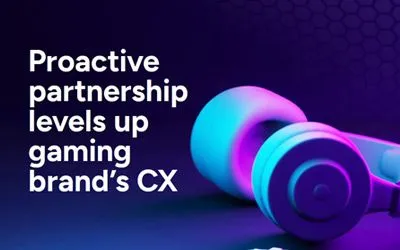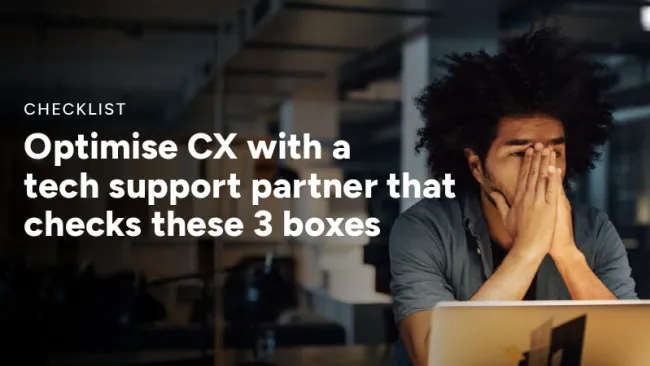
Proactive partnership levels up gaming brand’s CX
TTEC helps strike the right balance of expert support, proactive solutions, and workforce improvements
Proactive partnership levels up gaming brand’s CX
TTEC helps strike the right balance of expert support, proactive solutions, and workforce improvements
goal by 6%
Gaming brands have unique needs and challenges when it comes to delivering customer support. There are multiple volume surges throughout the year when new games or devices launch, and a tech-savvy customer base expects to have quick self-service support options at their fingertips.
A volume surge is what first led a global video gaming company to TTEC. After facing a sudden influx of customer enquiries, associates struggled to keep up with a growing backlog and customer experience (CX) suffered as a result.
More than 14 years later, we’re still the brand’s go-to problem-solver when CX issues arise, but we’ve deepened our relationship to become a true partner — combing through data, flagging potential issues, implementing proactive solutions, and even guiding the brand as it reimagines its workforce model.
Outsourced support makes quick work of volume surge
When the company first reached out to TTEC, its support team were having difficulty keeping up with mounting customer interactions.
The brand’s gaming systems included handheld controllers and many customers complained that when they played certain games, the controller slipped free from their hands, damaging the controller and nearby household items it struck.
The company decided to send all customers wrist straps for the controllers, but its in-house team needed help managing that process.
TTEC provided the associates needed to handle customer enquiries related to the controllers and the logistics needed to quickly ship wrist straps to customers. We provided 20 full-time-equivalent associates, and that number grew substantially as volume surged.
Based on that success, we continued to help the company deliver support to gamers during volume surges, including providing 1,300 associates during the pandemic in 2020.
Flexible scheduling boosts employee engagement and performance
Because of our longstanding relationship and the trust we’ve earnt over the years, the company recently became the first brand to pilot our FlexEX programme. The flexible scheduling solution incentivises associates to perform well and enables employers to tap into a broader talent pool.
With FlexEX, the top-performing 15% to 30% of associates are invited to choose which shifts they want to work. They request certain shifts, prioritise their selections, and once their shifts are set, the schedule opens up to the broader pool of associates.
FlexEX also gives associates more freedom around how they structure their shifts (within parameters set by the employers). An associate may opt to work one hour in the morning, for instance, and complete the remainder of the shift in the afternoon and evening. Employees can set the schedule that best meets their individual needs.
This type of workforce scheduling model marks a major shift for most brands, but the company trusted TTEC — and the decision paid off quickly. The client started by shifting 15% of its staffing to the FlexEX model in December 2022 and now has 100% of its associates using it.
Customised, proactive solutions aim to improve CSAT
Over time, our partnership with the client deepened; we dove into the company’s data and learnt the ins and outs of how its contact centre worked day to day. This perspective enabled us to identify challenges and roadblocks the company wasn’t even aware of, and to offer proactive solutions to overcome obstacles.
One area we focussed on is how the company handled refund requests, particularly in the chat channel. We analysed 90 days of data and noticed that refund requests, such as when downloaded video games were incompatible with devices’ software, consistently impacted customer satisfaction (CSAT) and dissatisfaction (DSAT). We examined the client’s existing refund process and found that refund enquiries that started via chat often escalated to voice and then further to back-office support, requiring as many as three or four employees to resolve issues.
Based on our findings, and by looking at pain points in the customer journey, we suggested workflow and back-office improvements that let customers resolve refund enquiries with as few as one contact. We also advised the company to add wording to its online game shop that warned customers when they were about to buy a game incompatible with their software.
These recently implemented recommendations are expected to decrease DSAT and improve CSAT.
We also advised the company to pay closer attention to DSAT overall when it comes to chat. TTEC monitored associates’ interactions with customers and provided a daily dashboard to the client detailing positive and negative customer experiences. With this information, the client proactively made better-informed decisions and changes.
The dashboard noted problems, such as too much “dead air” during a chat, but also offered solutions, like urging associates to keep customers informed about what they’re doing throughout the chat conversation to avoid lulls. This system also integrated associate coaching when needed.
Elevating CX, now and in the future
Our work with the company is far from done and our relationship keeps evolving.
Our associates feel as though they’re an extension of the brand. The client has provided us with every gaming console it’s ever made, so our team members could experience the product for themselves. Associates also get early access to new games before release to the public.
All of this means our associates are ready to quickly provide knowledgeable answers to customers’ enquiries. When players contact our support team, they’re interacting with associates who truly understand their gaming joys and frustrations, and who have the expertise to help.
We examine CSAT and DSAT data daily and report back to the client on what’s working and what’s not in the contact centre. We’re also continually monitoring and discussing KPIs with the company, ensuring we always have a clear understanding of what’s important, what the goals are, and what’s next.











